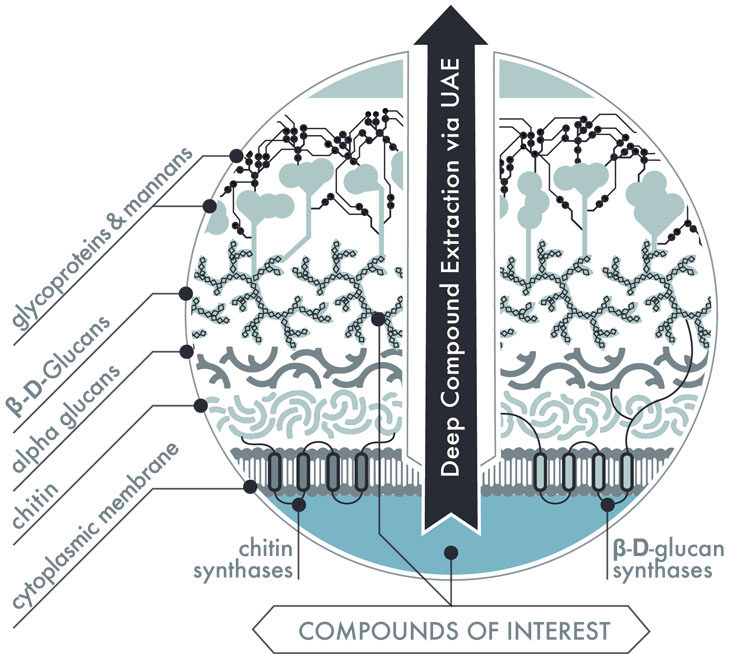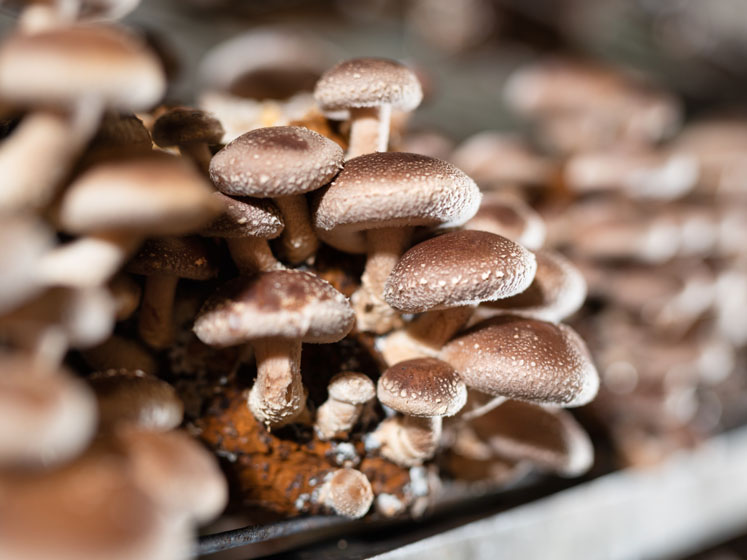Without an extraction process, many of compounds of interest would be locked within the chitin wall of mushrooms and would pass through the human digestive system untapped. Ultrasonic-assisted extraction (UAE) offers a safer and more efficient way to obtain them compared with traditional extraction methods.
Why is it important to extract mushrooms?
Unlike most other naturally sourced organic foods that can be eaten raw, such as fruits, nuts and vegetables, mushrooms require preparation prior to consumption to benefit from much of their nutritive goodness. And whereas plants are composed of cellulose, mushrooms are composed of chitin, which is a natural fibrous substance widely considered to be indigestible in the human gut.
Interestingly, insects and crustaceans also contain a lot of chitin. Our ability to digest chitin is based on the presence of chitinase in our gut, which is an acidic enzyme that can break chitin down: some people have it and some don’t.
Recent science has revealed that the presence of chitinase in our gut could be based on our diet.1
Moreover, the chitinous bonds in the mushroom are like a “locked chest,” holding valuable constituents that are beneficial to our health. Although cooking, pickling and other household preparations can enable the partial opening of this nutritive mushroom vault, there is one method of preparation that enables the optimal bioavailability of medicinal mushroom compounds: extraction.
Extraction has been around for thousands of years — as long as ethanol has been distilled — with archaeological records dating the first extraction apparatus at about 4500 years BC.2,3
In fact, even before alcohol was consumed, the process of boiling organic material in water (such as brewing a soup) is, in its essence, a form of extraction, as the hot water is enabling the release of taste, flavour and other nutritive compounds that may be locked within the organic foods into the soup’s liquid broth.
Cooking foods is, as such, an extraction process that enhances the bioavailability of nutritional compounds.

Figure 1: A representation of the fungal cell wall following the formation of a UAE solvent pathway that allows the COIs to be released
Until recent times, solid-liquid extraction has primarily been conducted by soaking raw organic materials (such as dried fruits, herbs or mushrooms) in a liquid extract solvent, such as water or ethanol. To date, ethanol has most commonly been used to extract soluble constituents from organic materials into the liquid solvent.
These extract constituents contain (what we at KÄÄPÄ Biotech call) compounds of interest (COIs) — the valuable and desirable mushroom compounds.
Put simply, many COIs are locked within the chitinous mushroom cell wall. Extraction ensures that these valuable compounds are made bioavailable and remain active for digestion and metabolism within the human gut. If non-extracted mushroom powder was consumed, most of these COIs would pass right through the gastrointestinal tract.
The COIs for KÄÄPÄ Biotech are the compounds that have been clinically shown to elicit health-promoting effects, such as the well-known and sought-after β-(1,3)-(1,6)-D-glucan, or simply beta-glucan, or the more exclusive energy generating cordycepin derived from cordyceps mushrooms (aka Himalayan Viagra).4
Furthermore, extraction also allows the concentration of COIs to be enhanced within an easily consumable dietary product. This is achieved by removing the spent (or extracted) mushroom filtrate, leaving only the concentrated COIs behind in the extract liquid, which can then be sold in pure liquid form or spray-dried into a powder form, turning it into a fully-soluble extract powder.
Another form, which is quite popular, is full spectrum 1:1 extract powder, which contains the extract and the mushroom filtrate in a combined form. Knowing all of this, extraction is indeed a fundamental process to create an effective mushroom supplement.
There’s conventional extraction and there’s UAE
In recent decades, extraction technologies have significantly improved and become more efficient.
These methods (think of them as “extraction recipes”) involve certain extraction factors and conditions, such as the choice of mushroom material, including its moisture content and grain size, the type and amount of extract solvent to use, the temperature or pressure for extraction, certain chemicals or enzymes for added effect or varying forms of energetic radiation such as microwaves.
Each of these extraction conditions plays a role on the quality and quantity of the end product. It’s a tricky and fragile business.
UAE technology increases the effectiveness and efficiency in full-spectrum mushroom extractions without damaging the treasured COIs.5
Similar to conventional extraction methods at an industrial-scale, UAE produces and concentrates extracts in large steel extraction vessels. The key difference is the integrated ultrasonic system. During extraction, this sends mechanical vibrations through the liquid slurry (usually at frequencies greater than 16 kHz or 16,000 cycles per second) causing huge pressure fluxes over or within tiny localised areas in the liquid slurry.

This causes what is known as acoustic or ultrasonic cavitation, which forms tiny pressure bubbles on the surface of the mushroom cells present in the solvent; these eventually implode or “collapse,” causing an opening in the mushroom cell wall and exposing the inner constituents to the extract solvent.
In this way, UAE is similar to a key that “opens the COI treasure chest” bound within the mushroom cell walls, readily releasing the COIs and optimising the extraction (Figure 1).
The key advantage of UAE is that it greatly optimises “mass transfer,” which describes the extract constituents coming out of the solid mushroom material and into the extract liquid. Put simply, it’s the primary goal of the extraction process.3,6,7 A summary of the benefits of UAE are presented below:
- dramatic increase in COI yield
- greatly reduced extraction time
- faster and more effective mixing and reduced reliance on additional extraction steps8
- reduced thermal degradation of thermolabile mushroom constituents as UAE requires lower temperatures compared with conventional methods
- less energy intensive process, making UAE a more environmentally sustainable method compared with conventional extraction processes
- removes the need for harsh extraction solvents, which can be replaced with Generally Recognised as Safe (GRAS) ones such as water to achieve full-spectrum extracts.9,10
Safety, efficacy and comparison of UAE
One of the key benefits of utilising UAE, which is often overlooked, is the fact that it offers a safe method of extraction compared with conventional methods — from production safety to consumer safety to environmental safety. UAE requires low-operating temperatures and no harsh solvents or chemicals, which contributes to operator health.
According to the scientific literature, UAE is more effective in deactivating microbial contaminants, pathogens or undesirable enzymes compared with conventional methods.11,12
Ultrasonic waves are also non-toxic and chemical-free. All of these factors improve the shelf-life, stability, quality and safety of products extracted using UAE, with the additional bonus of offering a more environmentally friendly method of extraction.
The moral of this story is that by continuously learning and investing in research and development, and keeping up with innovative nutraceutical solutions, industries can supply consumers with safe, high quality medicinal mushroom products.
Our focus with UAE technology is to produce the most potent mushroom supplement on the market by understanding and applying the latest research techniques and mushroom extraction technology.
One thing to know is that the technology is always advancing. Keeping current with these advancements ensures that the industry remains capable of providing honest and potent mushroom extracts — for the improved health and quality of life of everyone.
References
- E. Tabata, et al., “Chitin Digestibility is Dependent on Feeding Behaviors, Which Determine Acidic Chitinase mRNA Levels in Mammalian and Poultry Stomachs,” Sci. Rep. 8, 1461 (2018): https://doi.org/10.1038/s41598-018-19940-8.
- H.J. Bart, “Extraction of Natural Products from Plants – An Introduction,” in H.J. Bart and S. Pilz., Eds., Industrial Scale Natural Products Extraction (Wiley-VCH Verlag GmbH & Co. KGaA, Weinheim, Germany): https://doi.org/10.1002/9783527635122.ch1.
- F. Chemat, et al., “A Review of Sustainable and Intensified Techniques for Extraction of Food and Natural Products,” Green Chemistry 22(8), 2325–2353 (2020): https://doi.org/10.1039/c9gc03878g.
- J. Martel, et al., “Myths and Realities Surrounding the Mysterious Caterpillar Fungus,” Trends in Biotechnology 35(11), 1017–1021 (2017): https://doi.org/10.1016/j.tibtech.2017.06.011.
- N. Medina-Torres, et al., “Ultrasound Assisted Extraction for the Recovery of Phenolic Compounds from Vegetable Sources,” Agronomy 7(3), 47 (2017): https://doi.org/10.3390/agronomy7030047.
- F. Chemat, et al., “Ultrasound Assisted Extraction of Food and Natural Products. Mechanisms, Techniques, Combinations, Protocols and Applications. A Review,” Ultrasonics Sonochemistry 34, 540–560 (2017): https://doi.org/10.1016/j.ultsonch.2016.06.035.
- www.hielscher.com/most-efficient-botanical-extracts.htm.
- F. Chemat, et al., “Ultrasound-Assisted Extraction in Food Analysis” in S. Otles, Ed., Handbook of Food Analysis Instruments (CRC Press, Boca Raton, FL, US, 2016): pp 85–105.
- www.fda.gov/food/food-ingredients-packaging/generally-recognized-safe-gras.
- K. Vilkhu, et al., “Applications and Opportunities for Ultrasound Assisted Extraction in the Food Industry. A Review,” Innovative Food Science and Emerging Technologies 9(2), 161–169 (2008): https://doi.org/10.1016/j.ifset.2007.04.014.
- www.fda.gov/Food/FoodScienceResearch/SafePracticesforFoodProcesses/ucm103137.htm.
- M. Gallo, et al., “Application of Ultrasound in Food Science and Technology: A Perspective,” Foods 7(10), 1–18 (2018): https://doi.org/10.3390/foods7100164.
